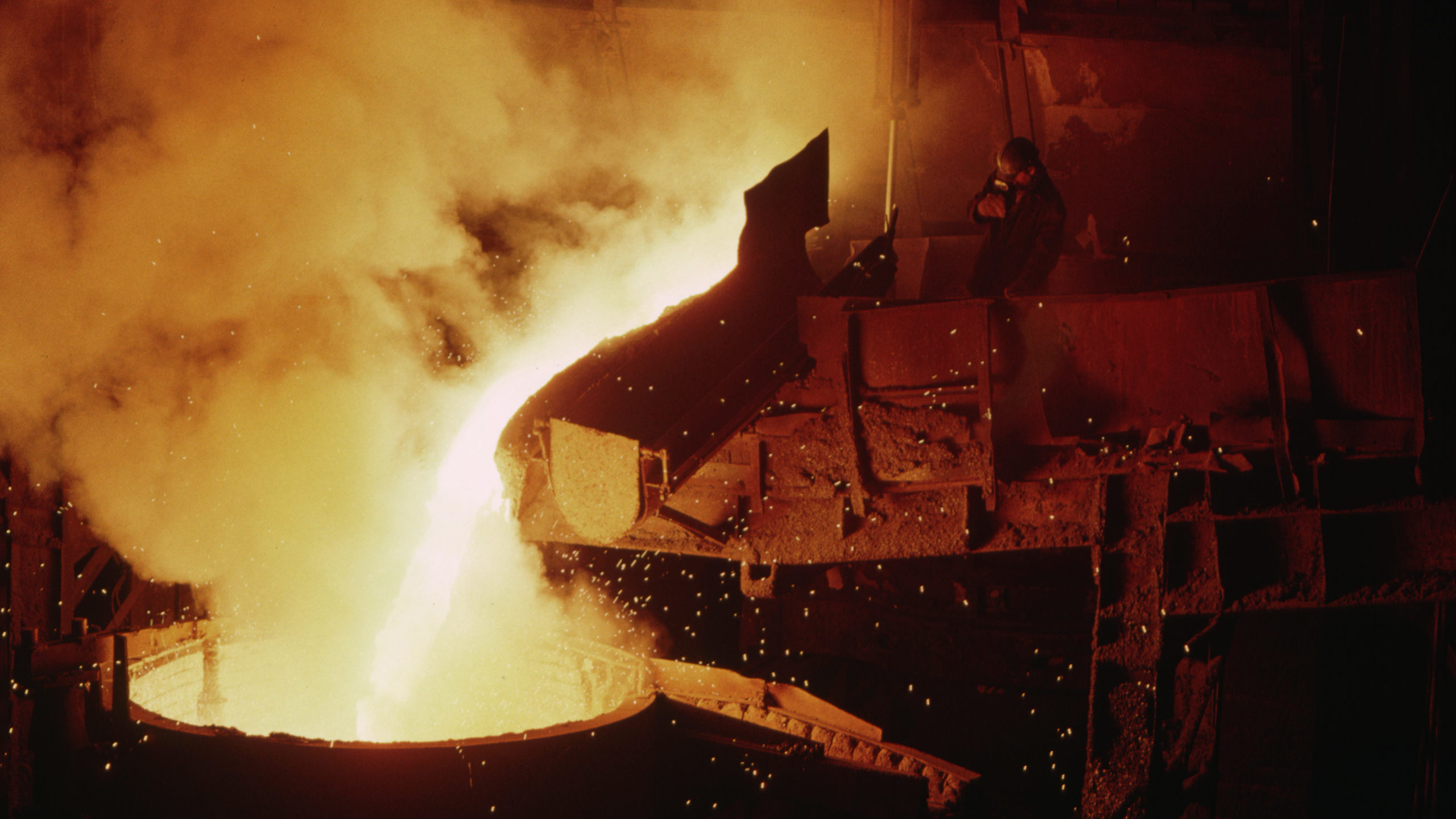Analysts say PCI could be the first coal grade killed by the energy transition; miners and traders have other ideas

Pic: Steve Raymer/Corbis Documentary via Getty Images
- PCI coal prices surged to record highs of around US$650/t after Russia’s invasion of Ukraine
- While that will be a short term boon for miners, analysts from IEEFA say hydrogen injection in blast furnaces could make it the first style of met coal to be phased out
- Tim Peirce from coal trader M Resources says PCI will be in high demand into the late 2030s at least as India drives steel demand growth
Coal may be seen as a dirty word, but right now it’s great business.
The big question is how long for? While momentum behind the green energy transition and decarbonisation would seem to muddy the waters for the future of the commodity, it’s not that simple.
Supply shortages of coal for both energy and steelmaking caused a massive swing for the industry to high prices and massive profits last year.
That situation has gone into overdrive since Russia’s war on Ukraine, which could see European businesses and nations restrict not only coal but also replacement energy sources like oil and gas from the belligerent nation.
Prices for coal from elsewhere like Australia shot through the roof in the immediate aftermath of the invasion in March and have remained high. It has also reconfigured demand impulses across the steel sector in particular.
PCI, a type of soft metallurgical coal used as a partial replacement for coke in blast furnaces, briefly traded at a premium thanks to Russia’s big role in supplying European steelmakers.
But in a new report, analysts Simon Nicholas and Soroush Basirat from the Institute for Energy Economics and Finance say efforts to replace PCI with green hydrogen could make it the first coal product to be phased out.
Nicholas told Stockhead energy security concerns and elevated prices stemming from the invasion would only accelerate efforts to displace PCI.
“At this stage of the technology transition, when you’ve got these extremely high prices, and who knows how long this situation in Ukraine is gonna go on for, plus renewed energy security concerns as a result of that that’s now elevated further,” he said.
“It’s longer term, but in the longer term that level of pricing, that level of concern about energy security will certainly overtake any concerns about carbon emissions.
“It is only likely to accelerate this shift even faster.”
What is PCI?
PCI or ‘pulverised coal for injection’ is a style of met coal that can be sold both into the steelmaking or thermal coal markets.
In steelmaking it is used as a cost effective replacement for coke at a ratio of 0.7-0.9kg of coke for each keg of PCI.
Most steel mills use a blend. Most blast furnaces, the most common method of producing steel globally accounting for 70% of global output, use 60-70% coke with a 30-40% mix of PCI.
In 2019 Australia shipped 31Mt of PCI, or around 63% of the global market. The only other major supplier is Russia.
But some miners, notably BHP (ASX:BHP) have shifted away from PCI and semi-soft coking coal mining in favour of higher quality hard coking coals.
Facing pressure from investors to clean up its portfolio and divest its fossil fuel holdings, BHP remains the world’s largest steel producer and is still committed to its high quality hard coking coal operations in Queensland in its joint venture with Mitsubishi.
But it plans to sell its Mt Arthur thermal coal mine in New South Wale and last week closed the US$1.2 billion sale of its 10Mtpa Poitrel and South Walker Creek mines to Stanmore Coal (ASX:SMR).
They’re two of the largest PCI and semi-soft coking coal operations in Queensland, and at current prices the well-timed acquisition looks like a boon for $2.2b Stanmore, which has increased its market cap nearly 10 times over since the deal was announced in November last year.
BHP chief analyst Huw McKay noted in his most recent economic and commodity outlook PCI could be threatened by its replacement by ‘low carbon fuels’.
But on the flipside BHP thinks we’ll still need steel and lots more of it to fuel the EV, infrastructure and renewable energy booms that will come along with decarbonisation.
The high penetration of blast furnaces in China, producer of 60% of the world’s crude steel and India, its fastest growing market, means coking coal will play a role in steel production for decades to come.
“On the topic of technological disruption, our analysis suggests that blast furnace iron making, which depends on coke made from metallurgical coal, is unlikely to be displaced at scale by emergent technologies this half century,” McKay says.
“The argument hinges partly on the sheer scale of the existing stock of long–lived BF–BOF capacity (70% of global capacity today, average fleet age of just 10–12 years in China – the major producer – and around 18 years in India – the key growth vector).
“It also highlights the lack of cost competitiveness and technological readiness (or both) that is expected to inhibit a wide adoption of potentially promising alternative iron and steel making routes, or high–cost abatement levers such as hydrogen iron making and carbon capture and storage, for a couple of decades at least in the developing world.
“Notwithstanding the current sweet spot in profitability under record pricing in many regions, steelmaking is a low margin industry where every cent on the cost line counts.”
Thyssenkrupp study
In November 2019 at a steel mill in Duisburg Germany, Thyssenkrupp successfully replaced PCI coal dust with hydrogen in one tuyere (literally a blow hole) of one of its blast furnaces in a Phase 1 trial.
Thyssenkrupp has blamed Covid for delays to the process. Phase 2 has started this year, with hydrogen to be injected through all 28 tuyeres at blast furnace 9.
Phase 3 of the trial, initially due to begin in 2022 before the pandemic, would see the process extended to three furnaces.
Around 200kg of coking coal and 300kg of PCI coal are needed for every tonne of pig iron produced at Duisburg, and Thyssenkrupp says it could reduce its carbon emissions by 20% if it can prove up hydrogen as a PCI replacement.
Over in Australia BlueScope Steel (ASX:BSL) is planning to trial the use of coke oven gas in the blast furnace at its Port Kembla steelworks, which contains 60% hydrogen, as a replacement for PCI and a potential byway to green hydrogen in the future.
While companies like Thyssenkrupp and ArcelorMittal plan longer term to shift to DRI, a process that theoretically could be run entirely with green hydrogen if the technology and economics stack up, the dominance of blast furnaces mean the displacement of PCI is a more achievable goal.
“Even more positive scenarios from the likes of Bloomberg New Energy Finance say there is going to be a need for some coking coal in the steel sector by 2050,” he said.
“Assuming some carbon capture and storage can be in place, there is a potential headwind for direct reduced iron processes when it comes to not just the cost of green hydrogen but also the supply of high grade iron ore because DRI requires a significantly higher grade of iron ore than blast furnaces in terms of iron content.”
Under a scenario where global warming is capped at 2C above pre-industrial levels, Wood Mackenzie says PCI coal use could fall by 50% by 2050.
For the steel sector to meet the ambitious 75% emissions reduction target, WoodMac envisages carbon, capture and storage will be required. Nicholas says high prices for PCI coal could accelerate the shift and that if CCS does not prove viable, steelmakers could further ramp up the rate of PCI substitution.
Demand for PCI to be strong for decades: trader
While BHP’s divestment of BMC hinted at its belief hard coking coal will be advantaged in a carbon-conscious world, it has been bullish on the use of coal in steel production and the future of steel demand, essential to its headline iron ore business.
Tim Peirce, chief commercial officer at coal trader M Resources, said future demand would growth come from Asia, where not only is steel production dominated relatively new blast furnace infrastructure, but where he says PCI’s displacement of coke brings environmental benefits as well.
“A tonne of coke requires transport of coal, that requires processing of coal, then there’s multiple handlings of coal as well as a conversion process, as opposed to PCI which is injected directly,” he said.
“So there are arguments that PCI has a net beneficial effect versus coke on emissions performance of the blast furnace today.
“Take India, for example, which is the main source of future growth of steel production, who are deploying greater PCI rates for the economic reasons above, as well as building larger blast furnaces which drives increasing PCI demand.”
Peirce estimates the global PCI market currently at around 60Mt, with around 35-40Mt supplied by Australia. About 8Mt will be sold through M Resources, which markets coal for Stanmore and Bowen Coal (ASX:BCB). Peirce says demand is currently so high it’s outstripping the trading firm’s ability to supply PCI.
Peirce said other “base case” scenarios presented by Wood Mackenzie on the energy transition by met coal suggested PCI demand will remain robust into the late 2030s at least.
“Their long term research report produced in 2021 suggested that you don’t see material PCI demand destruction by hydrogen until well into the late 2030s (noting that trials may commence in Europe through the latter part of the 2020s),” he said.
“Wood Mackenzie did subsequently produce a report which is the one that has been selectively referred to, which was a hypothetical ‘What if’ scenario in the case of very aggressive global forced policies on steel decarbonisation.
“We don’t see policy clarity and hence technology preference clear until the late 2020s. Then that has to be developed and matured.
“So we don’t really see that rolling out in any scale until the mid to late 2030s. Hydrogen as an injectant still has technical and economic barriers to overcome.”
Peirce said even at high relative prices, PCI remained cheaper than coke, making economic substitution less likely than it may seem.
“That is the primary reason why steel mills use PCI at all, because the more PCI, the less coke you have to use,” he said.
“That has two very important consequences. One is it’s a cost benefit.
“The more PCI used, the lower your cost of hot metal production.
“In that sense the value of PCI is not set even against a tonne of prime coking coal; the value of PCI is in the tonne of coke that it displaces.
“The notion that PCI (prices) can’t be at such high levels doesn’t fully take that into account.”
Miners entering the space are bullish too.
Bowen Coal has just begun mining at its recently acquired Bluff PCI mine in Queensland, which will produce up to 1.2Mt of coal a year.
Its executive chairman Nick Jorss, who also founded Stanmore, told Stockhead last week he saw a long term future for PCI demand.
“PCI is probably a market that not everybody wants to be in, right, some people see it as having a shorter lifetime in terms of met coal, but we’re kind of comfortable with the outlook for it,” Jorss said.
“It’s really tightened up now and its relativities are spectacular to hard coking coal.”
Stanmore Coal (ASX:SMR) and Bowen Coal (ASX:BCB) share prices today:
Related Topics

UNLOCK INSIGHTS
Discover the untold stories of emerging ASX stocks.
Daily news and expert analysis, it's free to subscribe.
By proceeding, you confirm you understand that we handle personal information in accordance with our Privacy Policy.








